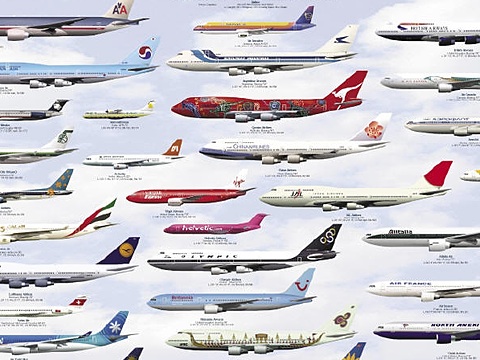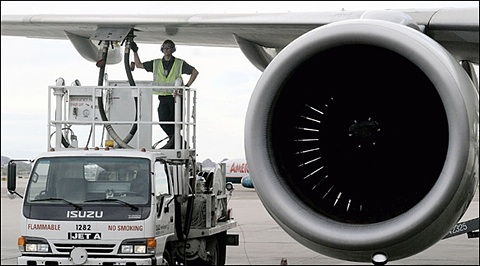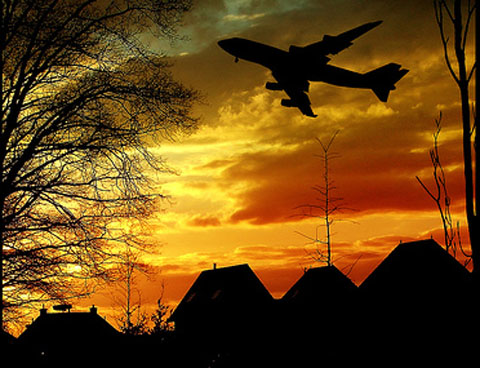www.islandbreath.org ID#0809-24
SUBJECT: AIRLINES COLLAPSE
SOURCE: BRAD PARSONS mauibrad@hotmail.com
POSTED: 4 JUNE 2008 - 11:30am HST
Airlines cash reserve waning

image above:Detail of "International Airlines" post at http://forum.skyscraperpage.com
by Harry R. Weber on 2 June 2008 in The Honolulu Advertiser Airlines are cutting U.S. flights, shedding employees, putting off plane orders and even talking about combinations. |
SUBJECT: AIRLINES COLLAPSE
SOURCE: DAVID WARD sayjaz3@hotmail.com
POSTED: 1 JUNE 2008 - 7:30am HST
You Think Flying Is Bad Now...

image above: A Northwest Airlines jet being refueled in Phoenix in 2004 when oil was $35 a barrel
by Dean Foust and Justin Bachman on 28 May 2008 for Businessweek To fully appreciate the impact that soaring oil prices have had on the nation's beleaguered airline industry, consider that U.S. carriers will likely spend $60 billion on jet fuel this year—nearly four times what they paid in 2000. Because of the spike in fuel costs, airlines now lose roughly $60 on every round-trip passenger, a slow bleed that puts the industry on pace to lose $7.2 billion this year, the largest yearly loss ever. Not surprisingly, Wall Street has become so dour about the industry's prospects—can you say federal bailout?—that the combined market capitalization for the six major legacy carriers and Southwest Airlines has fallen to just over $17 billion. That's about what ExxonMobil (XOM) books in revenues every two weeks. "The U.S. airline industry, as it is constituted today, was not built for $125-per-barrel oil," Gerard Arpey, the chief executive of American Airlines parent AMR (AMR), told shareholders on May 21. Consolidation Is Likely While the industry is no stranger to losing money—or reorganizing under bankruptcy, for that matter—experts nonetheless believe that the current crisis has the potential to profoundly reshape the industry in coming years. That means not only far fewer carriers than at present, but forcing the survivors to rethink every facet of how they operate, from ticket pricing to the very way they fly. "The problem right now is that no one knows where the price of oil is going to fall down," says Darryl Jenkins, an aviation expert at Ohio State University. "Right now you're just in kind of the worst of all possible situations. Your planning becomes 'What do we do to lose the least amount of money?'" If oil prices remain in the triple digits—above the $80-to-$90 break-even level for most airlines—it will accelerate the shakeout that is already occurring in the industry. While many carriers have in the past exploited bankruptcy as a competitive maneuver to cut costs, experts believe that any carrier that falls into Chapter 11 going forward will likely have to liquidate. That would probably include one or more of the major airlines. "I think the real risk this time is not Chapter 11, but [Chapter] 7—liquidation," says a senior executive of one major airline. "What happened to Pan Am? TWA? Eastern? I think there's a real risk here that some airlines just go away." A court-overseen bankruptcy also could help smooth the industry's transformation if creditors decide the environment is too hostile and agree to sell off valuable assets. Historically, airlines have attracted sufficient funding to operate while restructuring, and new capital when they exit. It's not clear that current market conditions—high oil prices and credit-squeezed lenders—would support that playbook. Airlines with the financial muscle to step in—think Southwest (LUV)—would be interested. Southwest historically has avoided major acquisitions and considers them a steep risk but clearly recognizes potential opportunity in a bankrupt rival. "It just gives the acquiring carrier a tremendous amount of flexibility to impose change that would otherwise be very difficult," says Southwest CEO Gary Kelly, whose company has remained profitable because of long-term fuel contracts. European Buyers Analysts say liquidations could well leave an industry consisting of two dominant carriers, most likely the combined Delta (DAL)-Northwest (NWA) and perhaps a combined American (AMR)-Continental (CAL), along with a couple of discount players like Southwest. "I think the industry is going to look more like Europe—a couple of far-flung carriers and then a bunch of little guys," says Roger King, airline analyst for CreditSights, a New York-based institutional research firm. Experts also believe that the oil crisis will eventually prompt Washington policymakers to drop their long-standing resistance to foreign ownership of U.S. carriers, leading to the first generation of truly global carriers. "The U.S. airlines badly need more capital to survive, and the only players with the resources to buy in are the [cash-rich] European carriers. Why would Congress object to that?" asks Robert Mann, an industry consultant in Port Washington, N.Y. That could give British Airways (BAY.L) the opening for the acquisition of American it has long coveted, and a similar move by Lufthansa (LHAG.DE) on either United Airlines (UAUA) or JetBlue Airways (JBLU), in which it already owns a 19% stake. For all its aviation woes, the U.S. remains the largest, most lucrative travel market in the world. "Don't you think BA would fall over itself to buy American Airlines for $1.6 billion?" King says. "That's peanuts to them." Creative Pricing This consolidation will come with a cost: Experts believe that for the U.S. industry to shrink to a size that would allow the surviving carriers to earn a profit will require hefty fare hikes and a 20%-to-25% cut in capacity. That means fewer routes, fewer flights, and even more crowded planes. The biggest losers would be smaller cities like Cedar Rapids, Iowa, and Baton Rouge, La., that became accustomed to dozens of daily flights, usually on 50-seat jets that the majors use to feed traffic to their hubs. But oil priced near $130 has rendered those smaller jets uneconomical, meaning that carriers are likely to fly one much larger plane on marginal routes each day, but no more. "We might keep one flight just to keep Congress off our back," muses one industry executive. Coast-to-coast flights will change, too. With roughly 30% of the weight of any transcontinental flight consisting of the fuel alone, meaning airlines are burning fuel just to carry fuel, carriers can be expected to replace many of those longer nonstops with one-stop flights, intended largely for refueling. The era of cheap fares will end, too. Since deregulation in 1978, fares have fallen by more than 50% in real, inflation-adjusted terms. Prices will rise, and airlines will become even more creative in how they set fares. Some experts like Mann wonder if carriers won't begin charging passengers by weight, as air-freight companies do to transport goods. "There's a huge cost difference between flying a grown man and a 50-pound child," Mann notes. Industry executives say they can't see that happening any time soon—"too politically incorrect," as one notes. Adds Southwest's Kelly: "I just don't think it makes a lot of sense." But the airlines will take other steps to wring more cash out of passengers, as American did last week in announcing plans to charge $15 to check a bag starting June 15. It will mean selling even more classes of service, and charging a premium for window, aisle, and exit-row seats as well as those at the front of the plane. Airlines will also create more levels of service off the plane as well, starting with a separate class of check-in, boarding, and baggage-claim service for travelers willing to pay more for the privilege of zipping in and out of airports quicker. Technical Upgrades The fee changes and higher fares are likely to cull millions of poor and middle-class travelers from the ranks of regular fliers, ending an era of $99 cross-country fares and bargain-basement weekend flights. It is also likely that Americans will see a far larger array of new travel products being sold at airline Web sites, such as aggressive hotel packages and travel insurance. But even airline executives admit that this is all chump change compared with what they could save if they could lower the costs of operating their current fleets of fuel-guzzling jets. In a different environment, that would mean eventually phasing out the traditional cigar-shaped planes the industry flies with a more efficient mode of transport. Engineers working on Boeing's (BA) X-48 Blended Wing Project designed a jet that uses nearly 25% less fuel—think of a Stealth Bomber-shaped plane that resembles one giant wing—but the design limitations (no easy exit, nor windows for passengers to look out) mean that the planes are likely destined for military use. Airline executives think they can wring out comparable savings by prodding Congress to fund the long-stalled modernization of the FAA's air traffic control system, which still relies on 1950s-era radar to route planes. Replacing it with a GPS-based system would cost the government and industry a collective $47 billion to implement, but executives say it could save the industry billions in fuel costs each year. If pilots could fly point-to-point, that could cut the circuitous, 585-mile path they currently must follow between Boston and Washington D.C. by as much as one-third, for instance. A Lovely Bunch of Coconuts But developing a GPS-based system could take a decade or more, and in the meantime airline executives are exploring ways to reduce their reliance on jet fuel, a kerosene-based oil that currently costs roughly $4.09 a gallon, up 98% in the past year. But developing an alternative hasn't been easy: Jet fuels have to pack enough oomph to power jet engines and at the same time be dense enough not to freeze in the air at -40C—a temperature that turns most biofuels into solids. But progress is coming. The Pentagon, which buys more aviation kerosene than any other group, has successfully tested a jet fuel made from liquefied coal. Airbus, meanwhile, is leading a consortium on a project to replace a third of jet fuel with advanced biofuels extracted from algae and plant oils. The efforts will help lower fuel costs and reduce dependence on crude oil. This past February, Virgin Group CEO Richard Branson christened the first-ever commercial flight powered by biofuels. In its test flight, Virgin flew a Boeing 747 running on a blend of oils from coconut and Brazilian babassu trees, produced by Seattle-based Imperium Renewables. "Two years ago, we thought this was pie in the sky," says Billy Glover, managing director of environmental strategy for Boeing's commercial division. "But things have evolved very rapidly. Our guess is that in five years we could have commercial biojet fuels on the market." Projected cost: Around $2 per gallon, or a third less than current prices for aviation kerosene. Coupled with higher fares, biofuels would be cheap enough for airlines to turn a profit. These days, that'd be enough to make many an airline executive go out and collect the coconuts. |
SUBJECT: AIRLINES COLLAPSE
SOURCE: DAVID WARD sayjaz3@hotmail.com
POSTED: 19 MAY 2008 - 7:30pm HST
Say Goddbye to Air Travel

image above: Sunset for commercial jets - and the suburbs they fly over
|
see also:
Island Breath: End of Air Travel 5/1/08
Island Breath: Aloha to Aloha Air 4/14/08